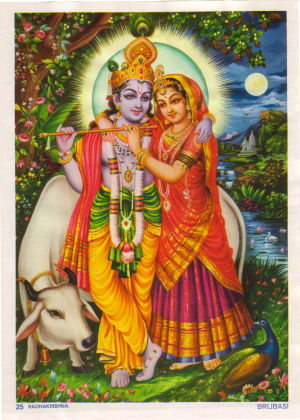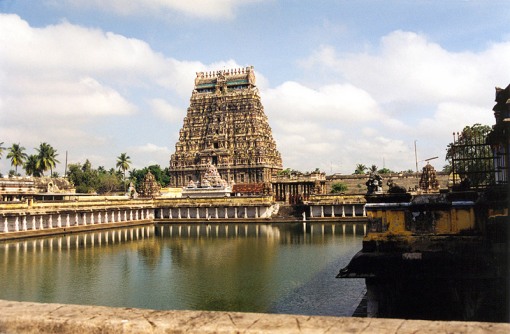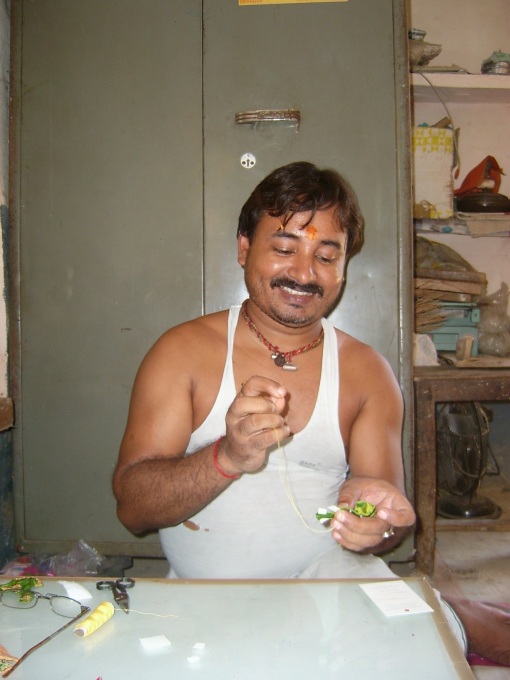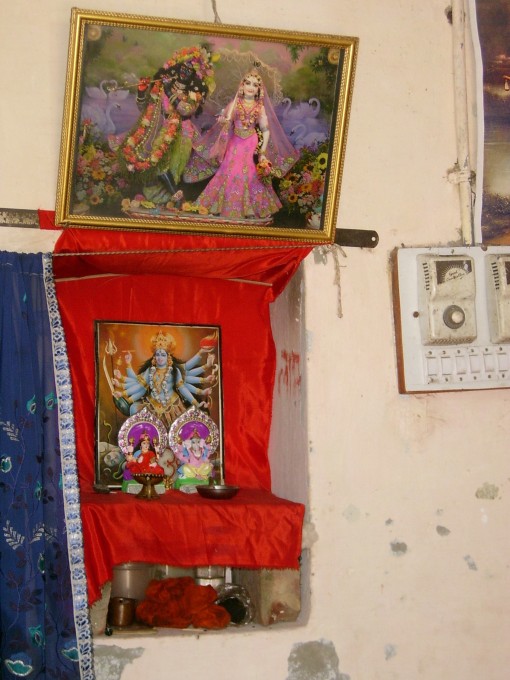
Meenakshi Temple
Arrived in Madurai at 3pm, Monday August 3rd and found a small Hotel (Sri Devi Hotel) with stunning roof views of the incredibly beautiful Meenakshi temple. Showered, changed into sari and rushed off to try my luck with taking darshan of Meenakshi Devi.
The present temple was built in the 17th century, but it’s history goes back to the Pandhya kings around 2000 years ago.It is believed to have been destroyed in 1310 by the infamous Muslim invader Malik Kafur.
The temple has two main sanctuaries dedicated to Sundareshwara (Lord of Beauty) and Meenakshi, his wife. The temple complex houses 14 magnificent Gopurams or towers including two golden Gopurams for the main deities, that are sculptured and painted in the elaborate Dravidian style.There is a fabulous thousand pillared hall and it is estimated that there are over 33 million carvings in the temple!

Hotel Roof Top View

Another roof top view
I was refused entry to the inner sanctum for not being a Hindu at the first attempt. Thus began a merry-go-round of pass-the-parcel (me = parcel) with the temple administration. I pleaded my : ‘I’ve-been-a-practising-Vaishnava-for-over-20-years’ case with the Deputy Officer, the Superintendent, the Joint Commissioner and finally after a two hour wait across town, with Rajendra the local branch head of the Arya Samaj. He in turn put me on the phone to the President (Subodh Chander) of the Tamil Nadu Arya Samaj.
Each interview was met with sympathy and understanding, but the bottom line was I needed a Hindu Conversion Certificate to enter the inner sanctum of the temple where the deity of Meenaksi resides. The President offered to perform a shuddhi ritual for me and also a fire sacrifice (homa), amongst else which would entitle me to my certificate. I was told that I should wait in Madurai until next week when he would be visiting and all this could take place.
Rajendra showed me the elaborate certificate with a signed declaration of ones conversion to Hinduism complete with photo id.
I then asked the President if all this was necessary just to have a two minute darshan of Meenakshi and could I just go and see her in the morning. Finally he agreed that since I had to leave tomorrow, and that I did not in fact need to perform any Hindu rituals personally, it would be alright to see Meenakshi without more formal qualification. He further added that if there was anything else he could do to help, he was at my service.
An arrangement was thus made for me to meet with Rajendra at 9am at my Hotel the next morning when he would take me to the shrine.
Next morning I waited for an hour and Rajendra did not show up and the phone number he had given me remained switched off. I finally gave up and decided to catch the bus to Ramesvaram instead.
En route to Ramesvaram (4 hours) I mentally churned the whole idea of what it means to be a Hindu. In our Hindu Studies classes this first introductory class always produces divided opinion, as we expect. The origin of the word ‘Hindu’ is explained as a term designated by the Persians for those people living beyond the river Sindhu. It was not a term these people applied to themselves nor did it refer to a single tradition. It was an umbrella term for a wide range of beliefs and practices with many over-lapping similarities. Along with an over-view of the historical development of the term, the class also debates the issue of birth vs character and practice in defining a Hindu. There is usually lively debate on the subject just as there always has been within Hindu traditions themselves.
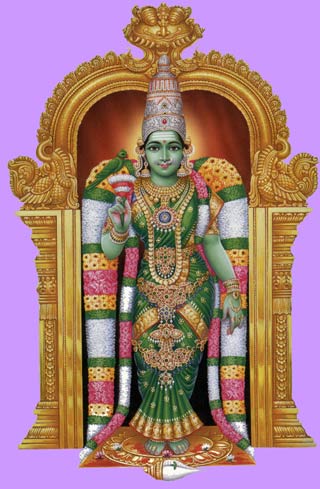
Meenakshi Devi
These varying perspectives are always stimulating but here in Madurai, to find myself on the receiving end of a personal rejection, aroused a surprising sense of hurt and indignation. Travelling to Ramesvaram, I mentally relived all the ‘He-said-and-I-saids’ and all the ‘I-could-have –said-and-should-have-saids” of the previous day. The energy behind my mental rant was interesting and I couldn’t seem to just let it go or ‘drop-the-bone’.
Then, sitting there on the over-heated gear box of the bus my eyes caught sight of the smiling face of the Goddess Meenakshi looking directly at me from the front of a shopping bag at the feet of the lady sitting directly before me. She appeared to be looking directly at me with kind smiling face and right hand uplifted in the pose of benediction.
Instantly all mental angst evaporated in that smile. It seemed that all the codes or laws of any particular brand of religion or tradition seemed in that instant unable to restrict or contain the workings of the Divine. I may not be allowed access to Menakshi in her shrine, but that is not to say Meenakshi is restricted in her access to me. The divine female principle is a lofty theological concept way beyond my grasp or understanding but such a well-timed smile from a handbag panel did more for me then than theology could ever achieve.
The whole episode reminded me of a T-shirt I saw in Jaipur:

God is Too Big To Fit Into One Religion
My journey to Ramesvaram from then on became a peaceful and happy pilgrimage and despite a little hour and a half hitch along the way I arrived in time to bathe and take darshan with no problems at all at the Ramnathaswami temple, with the famous Shiva Linga said to be fashioned originally by Sita devi from sand and installed here by Lord Rama.
Got back to Madurai around mid-night feeling tired, happy, healed, and resentment free.
Dayananda Sarasvati(1824-1883) founder of the Arya Samaj initially employed the shuddhi ritual to purify and readmit the Hindus who had converted to Islam or Christianity; however, soon it was made into an instrument of conversion to Hindu tradition redefining its essence from birth to belief.

A little Hitch on the way

Bathing at Ramesvaram









